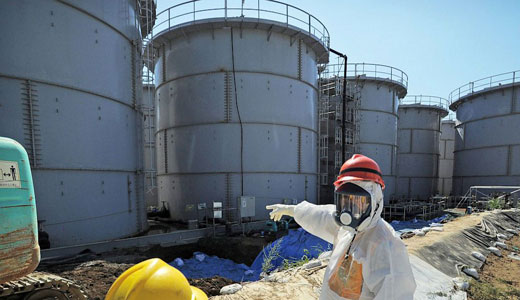
Typhoon Wipha – a once-in-a-decade storm – is making its way across the Pacific and is expected to hit Tokyo by the morning of October 16. It will bring hurricane-force winds, rain, and flooding to a city that is already enduring the now-global Fukushima disaster. Many in Japan are fearful, as Wipha could worsen the aftermath of the incident, which includes an ongoing leak of irradiated water into the sea.
The Tokyo Electric Power Company (TEPCO), which operates the decimated nuclear power plant, said it will cancel offshore work, and may suspend onshore work in the facility, in light of the storm. Such measures have been deemed necessary in cautious preparation for the storm, which is the strongest to approach eastern Japan since a cyclone that occurred in October 2004, killing nearly 100 people, forcing thousands to evacuate, and causing billions of dollars in damage.
The storm is currently making the transition from a cyclone to a full-fledged hybrid storm, with characteristics of both a tropical storm and an extratropical system – a combination similar to that of Hurricane Sandy, which tore up much of the U.S. East Coast when it hit last year.
Meteorologist Ryan Maue said that the storm poses a “huge flood potential” for the Fukushima area, meaning that the toxic water currently there could be at risk of spilling out in mass amounts and spreading. As an example of this, one could look at the recent flooding in Colorado, which was also caused by severe storms and which spread spilled oil and toxic chemicals throughout various towns.
Maue explained, furthermore, that the storm will likely strengthen and grow as it gets closer to Japan, aided by strong jet stream winds in the upper atmosphere. “And Wipha,” he added, “is extra-large already, size-wise.” Rainfall will also be severe: “Deep convection on the westward flank of the storm,” he said, “plus the topography of Japan, means heavy rain for the coastline regardless of the typhoon’s path.”
Meanwhile, typhoons notwithstanding, experts are scrambling to curb the fallout from the Fukushima fiasco, with a team of 16 experts from the International Atomic Energy Agency currently visiting the site and attempting to advise the Japanese government on how to deal with the scope of the disaster and the subsequent challenge of disposing of large amounts of radioactive material.
The experts will remain on-site for nine days, during which they will assess the extent of the radiation exposure and visit villages near the plant. Residents of some of those villages have still not returned because of contamination, despite the government’s lifting of evacuation advisories. This is seen as a larger part of Prime Minister Shinzo Abe’s overall plan to finally accept global assistance on this matter.
It could also be seen as a reactionary move in light of the public’s growing dissatisfaction with TEPCO, which has allegedly failed to fully disclose the extent of damage and water contamination caused by the disaster. Some experts are also dissatisfied with the government’s handling of the situation so far.
“Japan is clearly living in denial,” said medical doctor Kiyoshi Kurokawa. “Water keeps building up inside the plant, and debris keeps piling up outside of it. This is all just aimed at pushing off the problems until the future.”
But if Typhoon Wipha shakes things up as predicted, those problems will only grow.
Photo: A worker points to storage tanks at the Fukushima facility. The site is at risk of being hit by Typhoon Wipha. Kyoto News-Pool/AP










